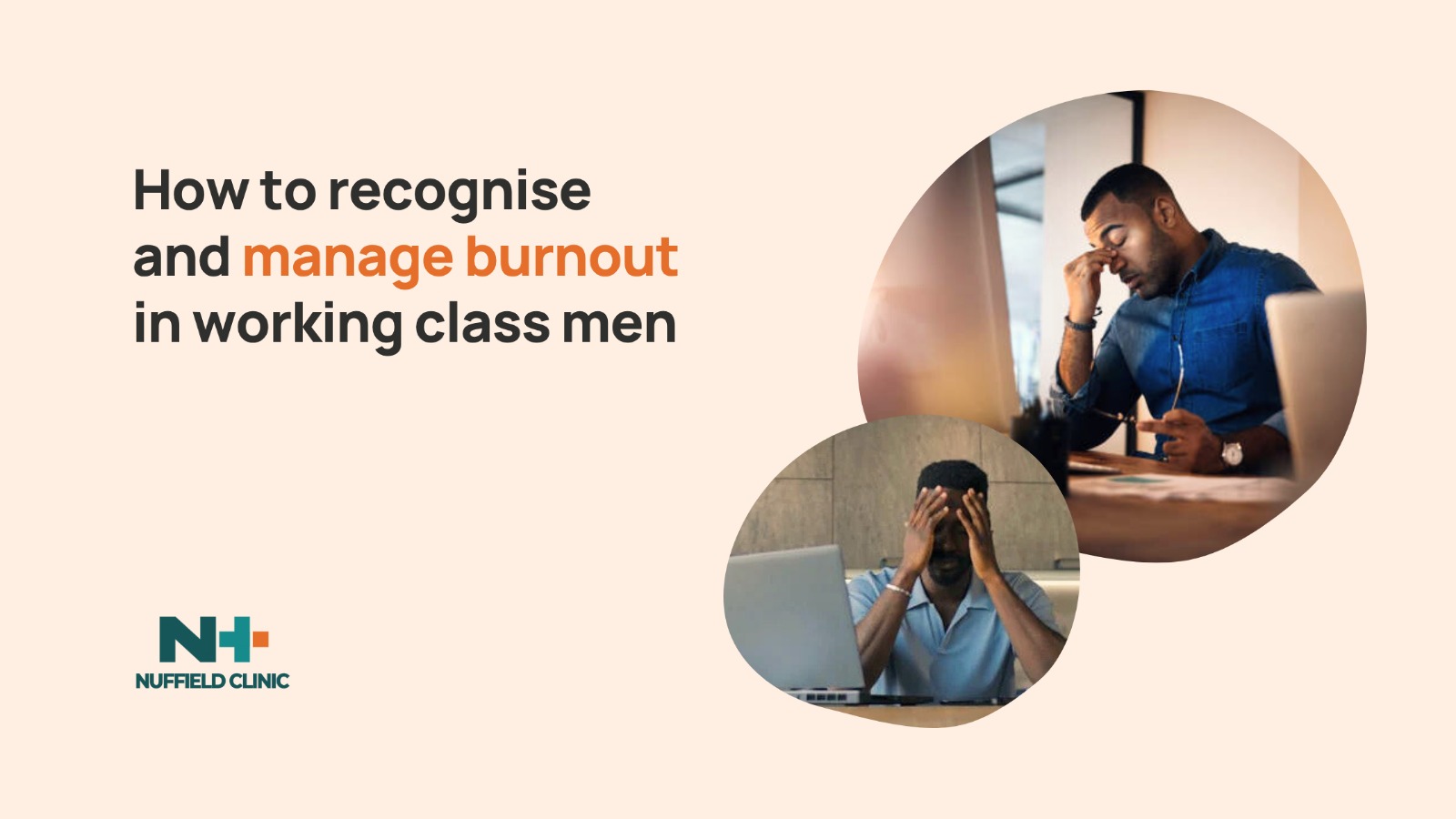How to recognise and manage burnout in working class men

How do you detect burnout as a working-class man? And how do you manage it properly? Burnout has become an increasingly common concern in high-performing workplaces, but for many professional men, it remains an invisible weight. The silence around it can delay both recognition and response, often compounding the impact.
Unlike short-term stress, burnout does not go away on its own, and when left unchecked, it can lead to lasting physical and emotional damage. Understanding what burnout looks like, how it progresses, and what makes professional men particularly vulnerable is essential for managing it early and recovering effectively.
Understanding burnout
Burnout is not simply feeling tired after a busy week. It is a deeper form of physical, emotional, and mental exhaustion that develops over time. The World Health Organisation describes it as an “occupational phenomenon” typically tied to chronic workplace stress, though it can also emerge from persistent academic demands, relationship strain, or caregiving burdens.
A person experiencing burnout often feels emotionally drained, physically depleted, and mentally detached. Work may feel meaningless, and the motivation to engage even in once-enjoyable tasks fades. There is usually a sense that no effort feels impactful or appreciated. These symptoms may resemble depression, but burnout is more specifically linked to the source of stress and may not affect all areas of life in the same way. However, burnout can increase the risk of developing clinical depression if left untreated.
How burnout develops
Burnout usually develops in stages, beginning with enthusiasm that can disguise early warning signs. In the early phase, a man might throw himself into work with energy and commitment, but neglect basic self-care. As stress starts to accumulate, irritability, anxiety, and declining productivity begin to surface. Over time, the nervous system remains in a constant state of alert, leading to chronic symptoms such as sleep disturbances or frequent illness.
Eventually, there is a collapse in the ability to cope. This is often when burnout is first acknowledged. In some cases, the individual may continue functioning in a depleted state for extended periods. Without intervention, burnout may become habitual, making recovery longer and more complex.
Early signs that should never be ignored
Burnout does not appear suddenly. It leaves clues that become more pronounced with time. Constant fatigue that does not improve with rest is one of the earliest signs. Men may also notice they are more irritable, impatient, or withdrawn. Interactions at work and at home may become strained, and there may be a growing sense of cynicism or detachment.
Some describe the feeling as being emotionally numb or disconnected from their surroundings. Tasks that once came easily now seem difficult, and concentration suffers. There may also be physical complaints like headaches, digestive problems, muscle tension, or changes in appetite and sleep. As enjoyment in hobbies and social activities fades, a man may find himself isolated, even from close friends or family.
Why men are more vulnerable
Burnout is not gender-specific, but certain societal expectations make men more susceptible in specific ways. Traditional notions of masculinity encourage emotional restraint and discourage vulnerability. Men are often conditioned to suppress signs of stress or distress, interpreting them as personal failure rather than signals of imbalance.
Professional environments can reinforce these beliefs by rewarding long hours, constant availability, and over-commitment. Setting boundaries may be perceived as lacking ambition or resilience. This makes it harder for men to admit they are overwhelmed, even to themselves. As a result, help is often sought late, if at all.
Men also tend to have fewer outlets for emotional expression. While some have strong personal networks, others may find it difficult to discuss their struggles with friends or family. When social isolation is combined with high self-imposed expectations, the risk of burnout increases significantly.
Strategies for managing burnout
Recovery begins with recognition. Acknowledging burnout is not an admission of weakness, but a demonstration of self-awareness and responsibility. Taking steps early can significantly shorten the recovery timeline.
One of the first areas to address is physical health. Consistent sleep, regular meals, and daily movement are fundamental. Even a short walk or ten minutes of stretching can improve energy and reduce stress levels. Reducing caffeine and alcohol intake can also help restore the body’s natural rhythms.
Setting boundaries is another critical element. Define work hours clearly and stick to them. It is important to disconnect fully during breaks and avoid checking emails or taking calls outside work hours. Creating a dedicated workspace at home can help reinforce these limits.
Rebuilding social connections plays a protective role. Engaging in honest conversations with trusted individuals, whether friends, family, or colleagues, can relieve emotional pressure. Participating in social or professional groups provides a sense of belonging and shared experience.
Incorporating practices that calm the nervous system is also beneficial. Meditation, breathing exercises, or journaling help men regulate their emotions without needing to analyse or solve every thought. These activities support the body’s natural recovery process and improve clarity over time.
Reintroducing hobbies or interests outside work helps restore a sense of joy and identity. Even if motivation feels low, setting aside time for activities that are fulfilling can gradually reawaken interest and engagement.
Where possible, take planned breaks from work. Use vacation days fully, and avoid the temptation to stay connected during time off. Short breaks throughout the workday are equally important, helping to prevent the accumulation of stress.
Recovery strategies for men
Men benefit from reframing recovery not as a retreat, but as an active process of regaining strength and focus. Recognising how cultural pressure to appear strong or self-reliant can delay recovery is an important first step. Seeking help from a professional therapist, mentor, or coach should be considered a practical decision rather than an emotional one.
Exploring personal identity beyond achievement is also key. Productivity, performance, and external recognition are often emphasised in professional settings, but cultivating presence, stillness, and care can be equally restorative. Practices like meditation or quiet reflection allow men to experience balance without disengaging from ambition.
Applying objectivity to emotional experiences can be useful. Without rejecting feelings, men can look at the facts of a situation and assess them more clearly. This supports constructive problem-solving and reduces emotional overload.
Building resilience involves reflecting on challenges, learning from them, and developing strategies for future stress. The goal is not just to bounce back, but to become more equipped to handle pressure without being overwhelmed.
Men are encouraged to check whether their workplaces offer employee assistance programs. These often include mental health support, coaching, or counselling sessions at no or low cost.
Recovery duration and the employer’s role
Burnout recovery is not uniform. It can take a few months in some cases, while others may require a year or more to fully heal. The pace depends on the severity of symptoms, ongoing exposure to stress, and the strength of support networks.
Employers play an important role in prevention and recovery. Organisations have a responsibility to promote mental health through policies that support balance, provide manageable workloads, and encourage time off. Cultivating a culture where seeking help is accepted can make a significant difference.
Managers should receive training to spot early signs of burnout and understand how to respond appropriately. Flexible working arrangements and open communication about workload can reduce pressure and promote well-being. By fostering environments where physical and emotional health are protected, companies improve not only morale but also long-term productivity and employee retention.
Burnout is complex and deeply personal, yet it is also predictable and preventable. For professional men, the challenge often lies in recognising their presence and giving themselves permission to slow down. By learning to listen to the body, respect emotional signals, and establish meaningful boundaries, men can manage burnout early and avoid long-term consequences.
As a Physical Therapist, I often observe how unresolved stress and burnout affect not only the mind but also the body. Muscle tension, poor posture, reduced mobility, and persistent fatigue can all be signs of deeper strain. Supporting mental recovery improves physical outcomes, and vice versa.







